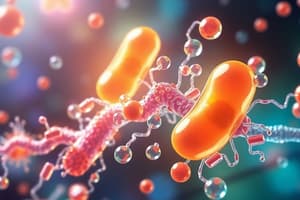Podcast
Questions and Answers
What type of toxin is responsible for necrosis of muscle tissues?
What type of toxin is responsible for necrosis of muscle tissues?
Clostridial phospholipase toxin
What is the result of phospholipase C activity on cell membrane phospholipids?
What is the result of phospholipase C activity on cell membrane phospholipids?
Cleavage of phosphatidylcholine to phosphorylcholine and diacylglycerol
What is the outcome of clostridial phospholipase toxin activity on cells?
What is the outcome of clostridial phospholipase toxin activity on cells?
Cell lysis and cell death
What is the clinical manifestation of clostridial myonecrosis?
What is the clinical manifestation of clostridial myonecrosis?
What is the specific phospholipid cleaved by phospholipase C?
What is the specific phospholipid cleaved by phospholipase C?
What are the two products formed when phosphatidylcholine is cleaved by phospholipase C?
What are the two products formed when phosphatidylcholine is cleaved by phospholipase C?
What is the effect of phospholipase C activity on cell membrane stability?
What is the effect of phospholipase C activity on cell membrane stability?
What is the enzyme responsible for cleaving phosphatidylcholine in clostridial toxin?
What is the enzyme responsible for cleaving phosphatidylcholine in clostridial toxin?
What is the outcome of phospholipase C activity on cell viability?
What is the outcome of phospholipase C activity on cell viability?
What is the term used to describe the type of necrosis caused by clostridial toxins?
What is the term used to describe the type of necrosis caused by clostridial toxins?
Flashcards are hidden until you start studying
Study Notes
Antibiotic Resistance and Cystic Fibrosis
- Antibiotics have different structural properties, affecting their zone of inhibition measurements.
- Etest strips measure antibiotic concentration gradients to determine the Minimum Inhibitory Concentration (MIC) of antibiotics.
- MIC is determined at the point of intersection on the Etest strip.
Cystic Fibrosis (CF)
- Affects multiple organs, but primarily the lungs, and cannot be cured.
- Primarily affects the lungs, but can also affect the pancreas, liver, and digestive system.
- CFTR (Cystic Fibrosis Transmembrane Conductance Regulator) modulators are used to aid digestion.
Antibiotic Resistance Mechanisms
- Resistance is multifactorial.
-
- Drug inactivation or modification.
-
- Alternation of drug target sites.
-
- Drug efflux pumps.
Clostridium perfringens and Gas Gangrene
- Causes traumatic gas gangrene, a histotoxic infection of wounds or ischaemic tissues.
- The toxin produces gas, spreading very fast and needing removal of the affected limb.
- Alpha-toxin is essential in gas gangrene, and its mechanism of action involves phospholipase C activity, cleaving the cell membrane.
- Steps to gas gangrene include:
- Traumatic wound contamination with bacteria
- Rapid growth and toxin production
- Extensive necrosis of muscle tissues
Studying That Suits You
Use AI to generate personalized quizzes and flashcards to suit your learning preferences.




